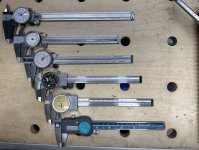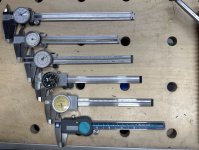I started as a machinist, so long ago that they didn't call it "manual", because there was no other way. Learned on traditional vernier type. We had Brown & Sharp at work, my personal one was Fowler. In a machine shop, calipers are a "guess-ta-meter" for non-critical measuring, even back then. Micrometers and optical comparators were the real thing.
I upgraded to a dial type in the 80s and still prefer them.
They use some digital model back at the edgebander, but batteries seem to be a hassle.
I have a cheap pair of the dial type in my main toolbox, but I don't use them much. It's just not that big of a thing for what I do.
Still have the Fowlers in the shop at home, for the occasional metal work. The dial ones just work, always.


